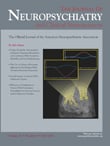To the Editor: Stiff-man syndrome, first described in 1956, is a very rare autoimmune disorder with a prevalence of 1:1,000,000 and is characterized by a constellation of neurological symptoms together with associated psychiatric features. The prodrome involves (a) stiffness and rigidity in axial muscles; (b) slow progression of stiffness to proximal limbs, making volitional movements and ambulation difficult; (c) a fixed spine deformity contributing to pronounced lordosis; (d) superimposed episodic spasms precipitated by sudden movement, loud noise, or emotional upset; (e) normal findings on motor and sensory nerve examinations; (f) normal intellect; (g) electromyographic findings typical of continuous motor activity that is responsive to diazepam; and (h) seropositive results for antiglutamic acid decarboxylase (anti-GAD65) autoantibodies.
1 The following is a case description of a consultation-liaison psychiatry patient admitted to the university hospital for a fall after being recently diagnosed with neurological symptoms of stiff-man syndrome.
Case Report
A 51-year-old white man came to the hospital after suffering a fall from his wheelchair to the concrete walkway at his home. He was complaining of weakness on his right side and numbness in his right foot.
During the hospitalization, a psychiatric consultation was requested by the primary team for assistance with intractable seizure-like episodes. In our initial consultation, the patient experienced one tonic-clonic seizure episode (mainly in the lower left extremities) which lasted 6 minutes. His vital signs were stable during the episode, and he was in a postictal confusional state for 1–2 minutes. He reported feeling very sore all over his body as though he had run a marathon. He denied ever having had any red urine, bowel/bladder incontinence, or auras. Notes and conversations with the physicians on the service revealed concerns that the patient may be experiencing psychogenic seizure episodes with the patient going into spells, kicking his legs on the bed boards and demanding his wheelchair. The EEG, CT myelogram, and head CT were all found to be within normal limits.
The patient had no prior psychiatric history. History revealed an onset of leg pain and falls over the last 6 months; he used a cane initially, then a wheelchair, while outside his home. He reported this to be preceded by symptoms of slight tremors in his legs while sleeping with occasional daytime twitching in his face. He also reportedly got symptomatic relief with a beer at night. He had seen other physicians in the past for diagnoses of histoplasmosis, causing blindness in his left eye, and for a similar brief episode of weakness and pain 4–5 years ago. He reported that rheumatologists at the time attributed that episode to a viral spondyloarthropathy. Of note, he underwent pacemaker placement after a diagnosed arrhythmia led to syncopal episodes. His current neurologist had diagnosed stiff-man syndrome and tried to support him with regularly scheduled appointments.
On examination, the patient had a cooperative attitude with a soft tone of speech, restricted affect, and euthymic mood; he reportedly felt well about leaving the hospital as soon as it was opening day for turkey season. He tended to minimize his symptoms and denied any neurovegetative symptoms of depression. However, on the Folstein Mini-Mental Status Examination, he faltered on recall, concentration, and attention with explicit short-term memory losses. While in the hospital, his supportive wife reported that noises (beeps of the cardiac monitor and loud visitors) tended to set off his spells. The steadily increasing doses of diazepam (now at 15 mg every 6 hours), baclofen (5 mg t.i.d.), and physical therapy consults had proven helpful in the course of his hospitalization.
On a follow-up neuropsychiatric evaluation, the patient experienced several episodes of blank stares and twitching during various parts of the comprehensive testing. Despite the patient’s subjective complaints, no problems were found with his memory. The repeated transient episodes underestimated his cognitive performance, leading the examiner to conclude that the deficits did not reflect a neurodegenerative process, but rather one consistent with conversion disorder.
Discussion
Due to the short duration of psychiatric symptoms reported, provisional diagnoses of an adjustment disorder with a mixed emotional state secondary to a diagnosis of stiff-man syndrome versus conversion disorder versus mood disorder secondary to postconcussion syndrome were offered.
Associations between stiff-man syndrome and epilepsy reveal a comorbid prevalence of about 10%, mostly with generalized tonic-clonic seizures.
2 A limited production of GABA within neurons due to autoantibodies directed against glutamic acid decarboxylase (specifically anti-GAD65 antibodies) necessitates high doses of GABA agonists.
3 As such, there is a partial response to diazepam and baclofen seen in stiff-man syndrome, with 50% of patients becoming wheelchair bound. The history of mild alcohol abuse in our patient sharply conflicts with anecdotal reports of patients using five shots of liquor to reduce the stiffness experienced. Along with the risks of chemical dependency, psychiatric comorbidity from stiff-man syndrome is commonly seen due to the relationship of stress and the remitting and relapsing nature of autoimmune exacerbations. Brain imaging and postmortem studies reveal reduced GABA-ergic pathways in the sensorimotor and limbic pathways and lymphocytic infiltration with gliosis suggestive of an inflammatory response. In theory, patients may be at particular risk for mood and anxiety syndromes due to impairments in GABA tone.
4Sixty-five percent of affected patients are unable to function independently due to symptoms of total body stiffness, phobias, anxiety spasms, and fall risks, requiring the use of walkers and wheelchairs, or are even entirely bedridden secondary to severe stiffness.
5 Stiff-man syndrome follows a course of slow progression or stabilization with favorable responses seen with close collaboration among psychiatrists, primary care physicians, and neurologists presenting cohesive recommendations for patients.

